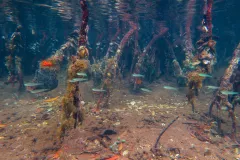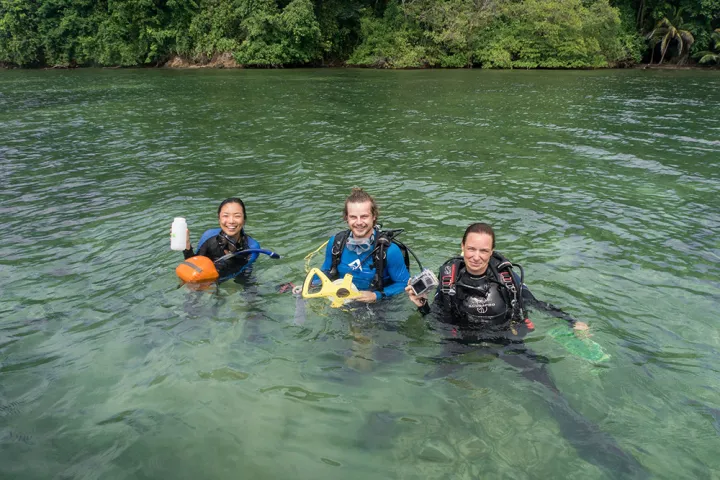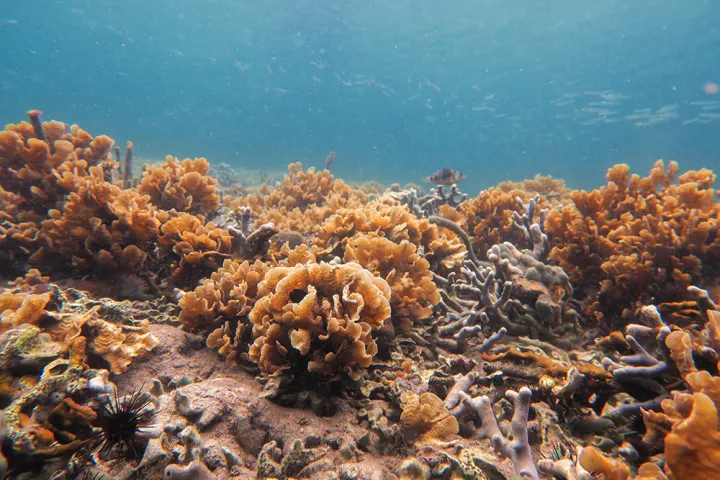On the Trail of DNA in the Ocean

DNA is everywhere—it can be found in hair, saliva, blood, bones, feces or even miniscule skin or scale particles. And organisms constantly shed DNA as they move through their environment. This environmental DNA, or what researchers call “eDNA,” is present everywhere on earth. The ocean is a veritable stew of eDNA waiting to be collected by scientists, and it may hold the key to answering questions about what ocean species live where.
In the summer of 2017, Smithsonian Fellow Bryan Nguyen and former Smithsonian Intern Elaine Shen spent time in the archipelago of Bocas del Toro, Panama, at a Smithsonian Tropical Research Institute research station, where they gathered water samples from the tropical lagoon in mangrove, seagrass, and coral habitats. Working as a team, they compared eDNA samples to a traditional visual survey method used to measure fish biodiversity in marine environments. Their goal was to see which species of fish were found by each of the methods, and if there was overlap, to determine if eDNA could accurately measure ecosystem biodiversity.
Knowing what is living in a particular ocean region or ecosystem can have important consequences for marine protected area (MPA) management and managing fisheries. The amount of biodiversity or the presence of rare species can influence whether an area should become an MPA. However, the more species there are, and particularly when many of them are rare species, the harder it is to find all of the species living at a location.
In the visual survey method, divers physically enter the water to count and identify every fish they see. This method requires researchers to have extensive taxonomic knowledge so they can accurately identify species. The reliance on diver knowledge means visual samples can have a certain number of errors—divers are, after all, only human. Small fish that hide in crevices are hard to spot, and water clarity and weather conditions can also impact whether a diver can see the fish and other marine organisms, or even enter the water at all.
The eDNA method removes some of the challenges that go along with visual surveys—poor visibility, bad weather and imperfect taxonomic knowledge don’t factor in. Divers aren’t necessarily required since water samples can be collected from the boat, and species are identified with molecular techniques in the lab. Organisms swimming in an area months ago do not normally skew your results when sampling for eDNA in the ocean because DNA in seawater usually deteriorates within a matter of days, leaving no question as to whether the identified organism has passed through the water recently. It is also increasingly inexpensive to do this kind of work.
But it’s not without other difficulties. Water samples must be handled in a sterile laboratory environment as eDNA, because there is so little of it, is very sensitive to contamination. And like other methods of assessing biodiversity, eDNA analysis has the problem of what are called “false negatives,” or organisms that are not found but are actually present.
While the final results of their research are not completely analyzed, Shen says that so far, the eDNA samples she gathered are dissimilar from the visual survey samples. This result doesn’t mean either of the methods is wrong—she hypothesizes this is due to the eDNA samples picking up a different subset of fish species within the water than the visual survey data typically identifies. Either way you cut it, the sampling method you choose will miss some species.
Despite the inevitability of “false negatives,” sampling with the eDNA method can be useful for researchers, such as Smithsonian Tropical Research Institute Postdoctoral Fellow Matthieu Leray. Leray’s research uses eDNA to gather biodiversity data about present day healthy coral reefs in order to establish a baseline of what’s normal. This information when compared to studies of less healthy areas, even if incomplete, helps us understand what’s been lost and, when doing ecosystem restoration, what to aim for.
The ability to identify every single species of fish or invertebrate within a biodiverse habitat still eludes us, but eDNA sampling is a technique that can be added to the scientific toolkit to enhance our understanding of an area’s biodiversity. And maybe one day eDNA will be able to help us tell the whole story, or at least most of it, much more easily.



